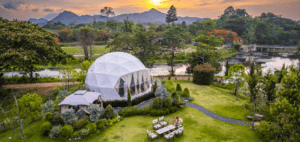Best Things To Do In Palma de Mallorca
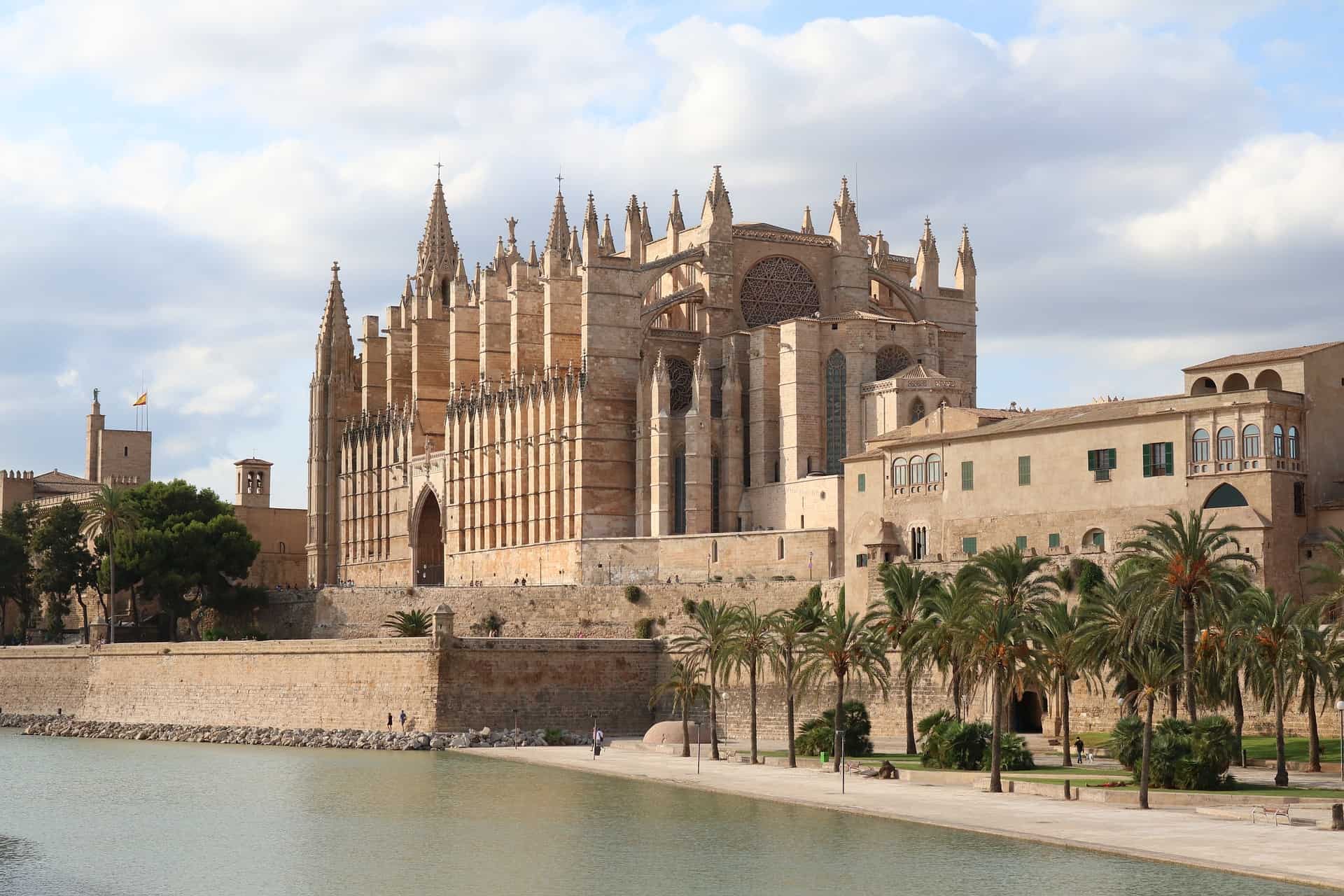
Updated On: November 09, 2023 by Esraa Mahmoud
Palma de Mallorca is a city of dreams and a real magnet in the heart of the Balearic Sea. Palma is the capital of the autonomous community of the Balearic Islands in Spain. The city par excellence of the Balearic Islands has 400,000 inhabitants living in it, which is already almost half of the population of Mallorca.
With its impressive fortresses and cathedrals, hip neighborhoods, stunning markets, and, of course, beautiful beaches, Palma de Mallorca has so much to offer. The old town of Palma is one of the largest ones in Europe, and it is the jewel of the vacation island Mallorca.
Palma is an island for nature lovers and active sportspeople, for people who like hiking or mountain biking. On Palma, there are volcanoes, cliffs, canyons, fragrant pine forests, and flowers in all colors. You can eat delicious fresh fish, visit markets (mercadillos) or take a boat trip and watch dolphins.
It is not just tourists who fall in love with the beautiful town as the royal family of Spain regularly visit Palma to enjoy the crystal waters, fabulous scenery, sports, and showbiz stars come here to unwind. With so much to offer, here is our guide of the best things to do in Palma and the amazing places to visit.
Old Town of Palma
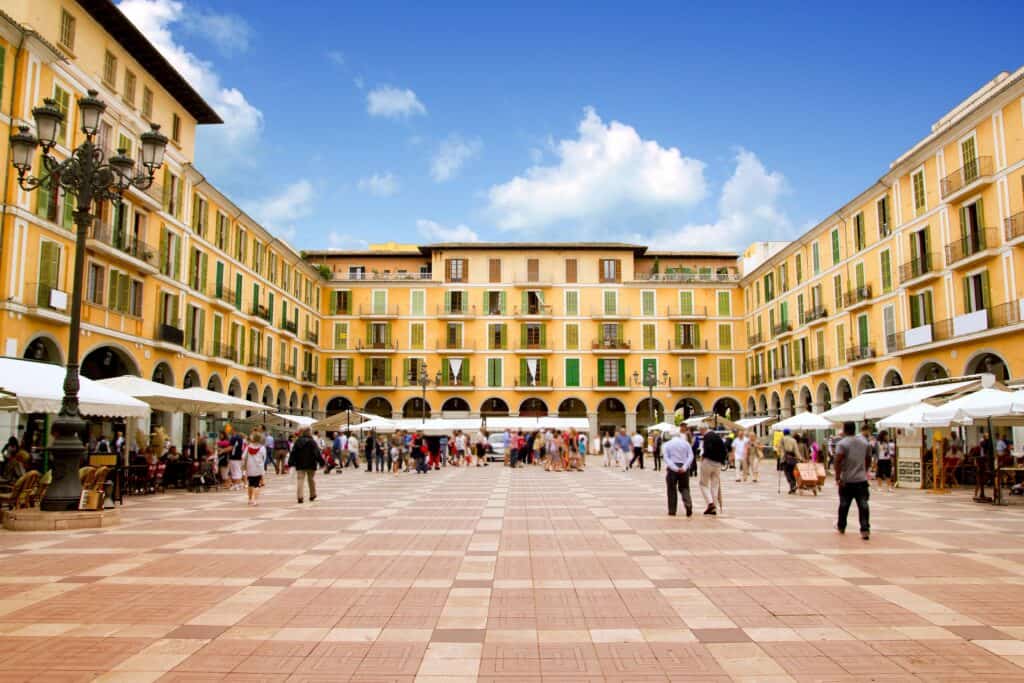
Palma’s old town is home to many of the city’s attractions, but the winding streets and wide promenades are also worth a mention in their own right. The old town is mainly car-free, making it perfect for exploring on foot.
On the larger shopping streets, there are many boutiques and small stores; if you want to go shopping in Palma de Mallorca, you are in the right place. In numerous restaurants and bars, you can enjoy Mallorcan delicacies and recharge your batteries while watching the hustle and bustle of the old town.
The Cathedral of Palma
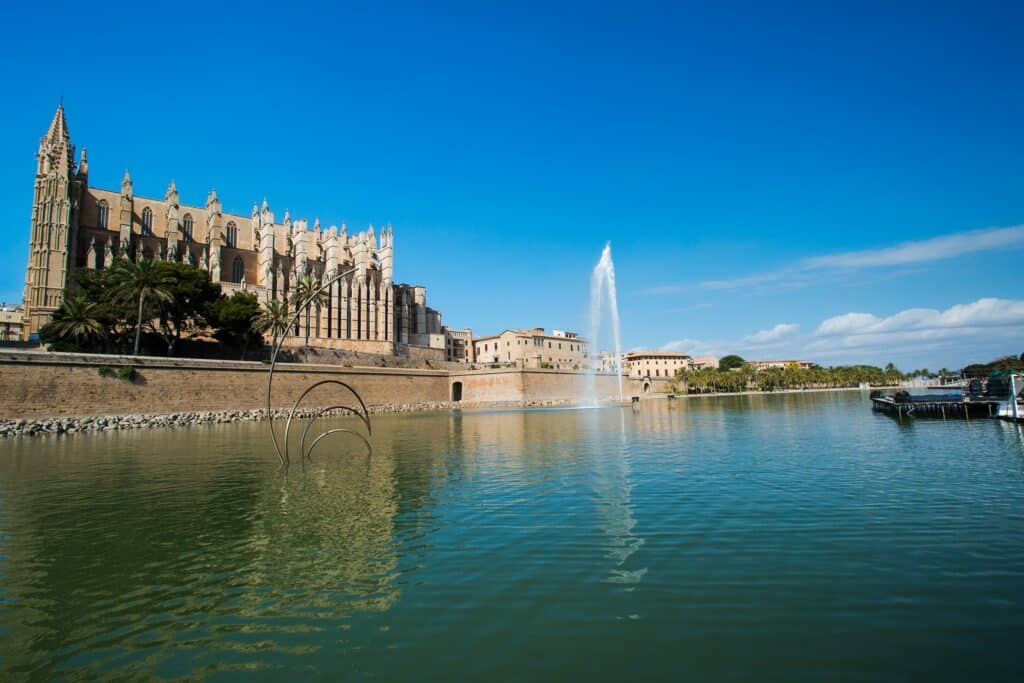
The Cathedral of Palma, also called “La Seu,” is the landmark of Palma with its facade and its huge rose window. The cathedral dominates the bay and offers a breathtaking view of the waterfront. The cathedral’s construction began during the reign of James II, and it has three naves on one floor, the main one of them houses the Chapel of the Trinidad, where the remains of the kings James II and James III are buried.
One of the peculiarities of Palma Cathedral is that the reconfiguration of the choir was carried out by Antoni Gaudí between 1904 and 1914 (yes, the same brilliant mind who also built the Sagrada Família in Barcelona). The impressive golden sandstone cathedral building is one of the tallest Gothic buildings in Europe, with almost 110 meters long and over 80 meters high; you will feel like an ant in front of the cathedral.
The cathedral was built on the site of a mosque; the foundation stone was laid in 1230. It took almost 400 years until the last keystone was laid in 1578. The whole building was finished only in the 20th century. Due to the long construction period, the cathedral has different architectural styles; there are Gothic, Baroque, Classicist, and modern building elements.
In addition to 8 other bells, the cathedral has Spain’s largest and heaviest moving bell. With a rich decoration, like most cathedrals in Spain, the Cathedral of Palma will dazzle you with its beauty. Even just looking at it from the outside, the cathedral is absolutely worth a visit. But inside, the cathedral is even more impressive.
Tip: Visit the Cathedral right after it opens at 10 a.m., then you can enjoy your visit before it gets crowded, and you can feast on the light that falls wonderfully from the east through the colorful windows into the cathedral. That is the best time and setting to have some amazing photos!
Royal Palace of Almudaina
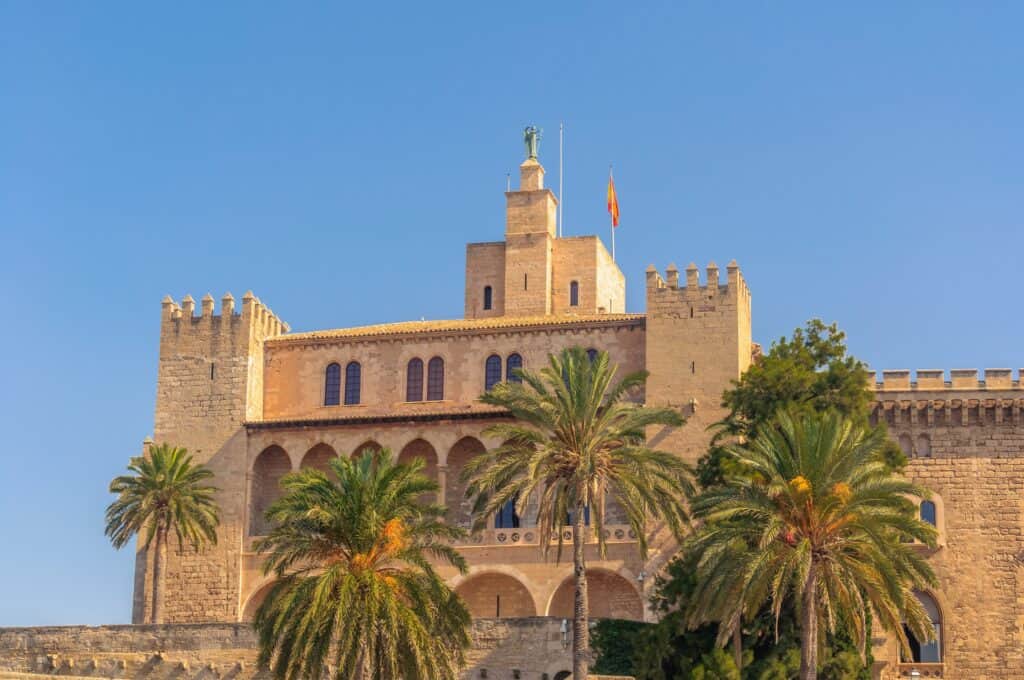
Located nearby to the cathedral, the Royal Palace is one of the most popular sights in Palma. It stands right next to the cathedral, and you can easily visit both sights on the same day. The Royal Palace of Almudaina is the royal castle of the city.
The 20,000-square-meter palace is only partially open to the public, as King Juan Carlos uses it as his official residence when he takes summer vacations in Mallorca or when he is on the island for festive and political occasions. When the king is present, the Spanish flag is hoisted on the roof.
The areas open to the public include the courtyard, the arcaded balcony, from where you have a magnificent view over the bay to Castell de Bellver, and the royal chapel of St. Anne. The palace is located on a cliff overlooking the port and the bay of Palma and offers breathtaking views not only from the terrace.
The former fortress of Arab origin represents the Muslim period of rule of the island as the palace used to be the residence for both Muslim rulers and, after the Christian reconquest, the Aragonese kings. The current castle is the result of the transformation of the Muslim alcazar, whose construction began in 1281. Despite the many rebuilds, some original Arabic elements can still be found, such as the windows of the main facade, which are in the typical Arabic ogival style.
The Almudaina was the seat of the independent kingdom of Mallorca during the reigns of James II, Sancho I, and James III until it passed to the crown of Aragon in the time of Peter IV. The Royal Palace is a work of art, and it is one of the best places to visit in Palma.
Llotja de Palma
Llotja de Palma is a large building of Gothic architecture located in the square of the same name, Llotja Square. The Llotja de Palma is a historic building and a masterpiece of civic Gothic architecture in Palma de Mallorca.
It was used in particular for the development of trade on the island of Palma. Being a masterpiece of Gothic architecture in Mallorca, the Llotja de Palma, was built by Guillem Sagrera between 1420 and 1452. It was a stock exchange and the seat of the college of merchants.
The building was first a simple goods depot, during the Napoleonic Wars, an artillery factory, and then a courthouse. Between 1886 and 1962, it was used as a museum of painting and archaeology, and now art exhibitions are held at the Llotja de Palma. The monumental entrance gate on the main facade to the east is particularly impressive. It has plant-shaped decorations and is crowned by an angel sculpture.
The four facades of the building have octagonal towers as side finishes, and ten smaller towers, corresponding to the distribution of the sections inside, serve as buttresses. The Llotja de Palma is located in the south of the old town, and it is one of the sights you don’t want to miss on your trip to Palma.
The Caves of Drach
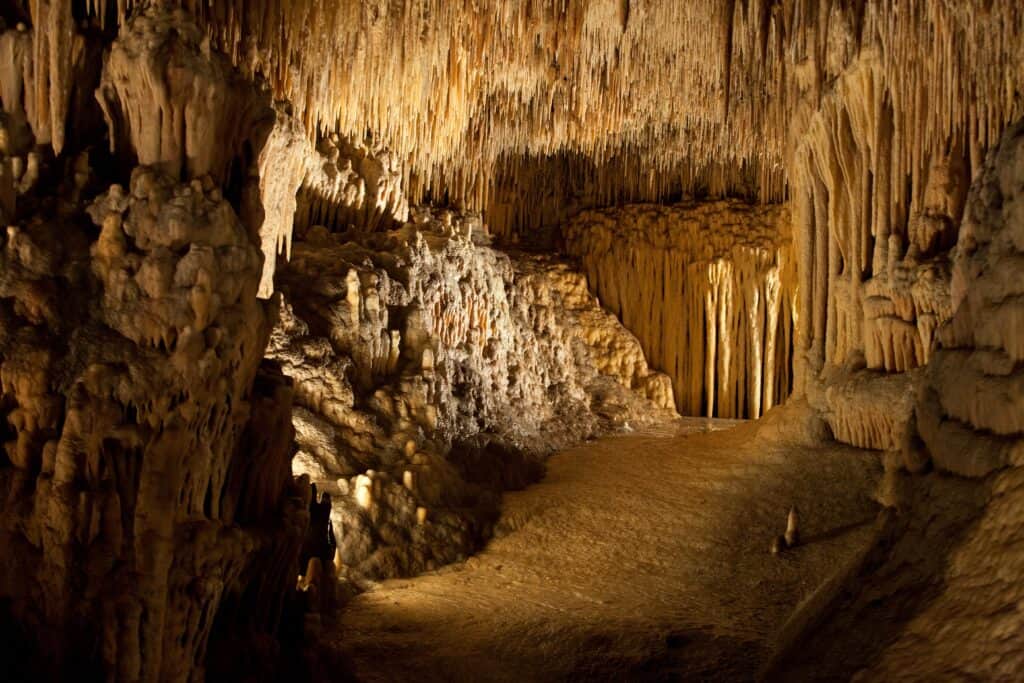
Located in Porto Cristo, about 50 minutes from Palma de Mallorca, the Caves of Drach, AKA Cuevas del Drach, are definitely worth a visit. This magical place is actually composed of 4 caves: the Black Cave, the White Cave, the Luis Salvador Cave, and the French Cave.
Nestled at 25 meters below the surface, the caves have some nice surprises in store for you. So don’t hesitate to venture in and be surprised by the secrets they hold. Among them, a secret de polichinelle, AKA the Martel Lake. Hidden inside the caves, this lake is considered as one of the biggest underground lakes in the world. Make sure not to miss a trip there!
It is impossible to go to Palma de Mallorca without passing through its caves; they are a perfect attraction to visit in Palma de Mallorca alone or with your family.
The Arab Baths
The Arab Baths, or Baños árabes – are the only surviving intact remains of the Muslim presence in Palma. Their conservation is impressive, and the garden that surrounds them is very relaxing. Their classic bull’s-eye dome rests on eight columns with rudimentary capitals.
The Arab baths, Banys Àrabs, date back to the 10th century and are one of the few remaining buildings of the Arabic period in Palma and the oldest known evidence of Arabic architecture in Mallorca.
It is worth mentioning that the plural “baths” is misleading here, though, as only a small area of the once-stately baths has been preserved; the vaulted steam bath is supported by 12 slender columns. The dome with the five star-shaped skylights through which the steam could escape is particularly beautiful.
The heating system is located underground, and the chimneys, steam, and water pipes are still clearly visible. You have to visit the Arab Baths while in Palma; they are like no other.
Jardines de S’Hort del Rei
Located behind the palace are the beautiful Jardines de S’Hort del Rei – the Royal Gardens of Palma. The gardens have magnificent orange and lemon trees, cypresses, acacias, and palms exude a pleasant fragrance and provide shade.
More than 100 years old, the garden was redesigned in the 1960s based on the gardens of the Alhambra in Granada. There are sculptures by Miró, Calder, and Subirachs scattered throughout the garden, with benches, and walls inviting you to linger while you listen to the water feature and soak up the garden’s unique atmosphere. The public garden is a small oasis of calm in the otherwise bustling city.
Mercat de l’Olivar
The Mercat de l’Olivar is one of Palma’s sights that will blow you away. When you enter the city’s largest indoor market, you’ll find yourself in a noisy world of colors and smells. The market is located in Palma’s old town and has been held daily since 1951.
In addition to traditional ingredients, you will also find current trends and wide national and international culinary offers. The fish hall is a particular highlight of the market: more than 30 vendors offer freshly caught, sometimes still live, fish and seafood.
There are also areas for vegetable, cheese, and meat vendors, and there is also a pastry shop, spice stands, various wine vendors, candy stands, and much more. In addition to the stalls, there are also small tapas bars where you can enjoy Mallorcan and international delicacies. For the locals, this is a regular weekly market; for tourists, it is definitely a Palma sight.
The Oldest Ice Cream Store in Mallorca
Speaking of food, you have to try Ca’n Joan de S’aigo, the oldest ice cream store, and café in Mallorca. Here, you can enjoy Mallorcan chocolate sweets in Spanish style and creamy ice cream. The store has been creating all sorts of sweet delights since 1700 and now even has two branches in Palma. The store’s atmospheric vintage interior will make you feel like you’ve been transported back in time.
Port de Palma
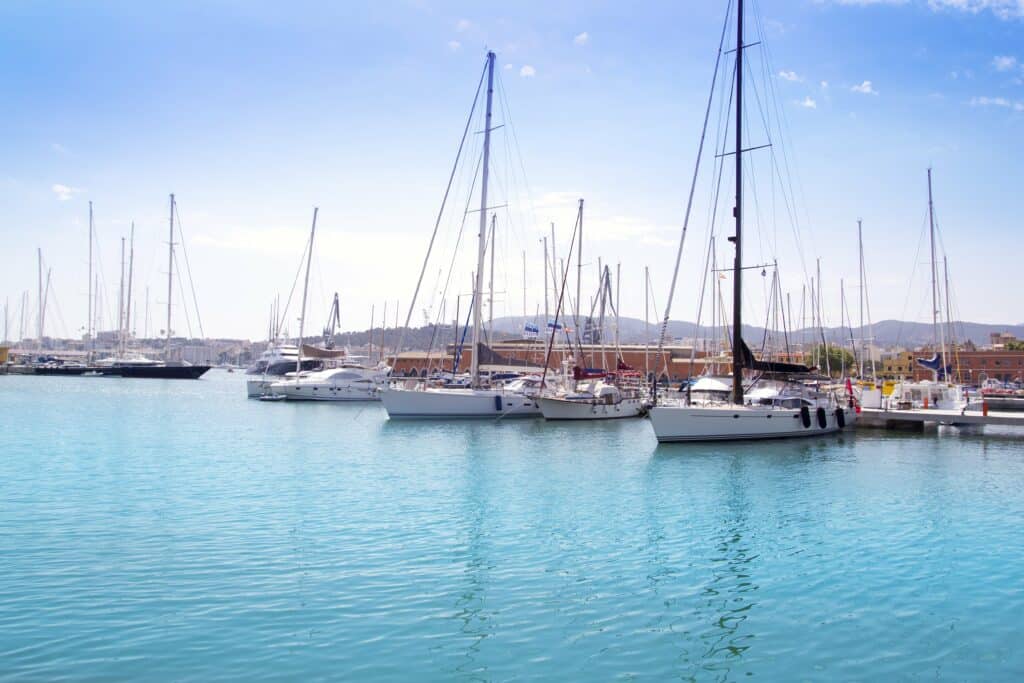
The Port of Palma is the gateway to the world for Mallorca; the transport of important goods for the island is regulated from here, and at the same time, thousands of cruise tourists stream through the port to the city of Palma every day.
The largest port of the Balearic Islands is located in the middle of the city and is a successful blend of tradition and modernity. Port facilities under the old town have been known since the Moorish rule.
The original facilities were hardly changed until the beginning of the 19th century, but this gradually led to bottlenecks. Since the beginning of the 19th century, construction has been almost continuous in order to adapt the port to the ever-growing demands.
The expansion of the port, which was completed in 1961, is the greatest engineering achievement of the island. Since then, the port of Palma has been divided into the commercial piers, the eastern piers, the docks for pleasure boats, and the western causeway.
The expansion has enabled Palma to establish itself as one of the most important cruise ports in the Mediterranean, with eight cruise ships now able to dock simultaneously. In addition, ferries to Barcelona, Valencia, or Formentera depart from here.
The waterfront promenade runs along the harbor, lined with large palm trees, and is worth a stroll, especially in the morning, when it is still a bit quieter in Palma. Port de Palma is one of the best sights of Palma.
Palma Aquarium
Another Palma attraction is the aquarium, which is a combination of an adventure park and an aquarium. In a total of 55 basins live about 8000 specimens from over 700 species of marine animals, a total of five million liters of seawater are used in the aquarium.
The tanks are individual biotopes, representing different areas and as close as possible to the natural replica of the actual habitat of the sea creatures. At the aquarium, you will be able to discover the flora and fauna of the Mediterranean Sea, the Indian Ocean, and the Pacific Ocean.
A special highlight is the Big Blue, one of the deepest shark tanks in Europe. Eleven specimens of two shark species live there: sand tiger sharks and sandbar sharks. If you are fascinated by sharks, you can cross the shark tank in a glass-bottom boat or even go diving with them.
If you are looking into a little less dangerous activity, you can go snorkeling with rays in the outdoor area. You can even feel like a sea creature yourself in the AquaDome, a 4D cinema, where you will experience the life of humpback whales in an exceptional way.
There is also a vast garden that adjoins the aquarium, representing the Mediterranean fauna. In the garden, there is an artificial sandy beach where sea turtles live and outdoor aquariums with rays and hammerhead sharks. In addition, the Palma Aquarium has one of the most extensive roof gardens in Europe. In it, you feel like you are in the Amazon, a seven-meter high waterfall rushes down a rock wall, and you can watch piranhas in a pool.
You should plan three to four hours for your visit to the aquarium. The aquarium is the perfect sight in Palma for bad weather or in winter.
Red Lightning Mallorca
The “Red Lightning” has been running between Palma de Mallorca and Sóller since 1912 and is a must-visit if you are on vacation on the island. The historic narrow-gauge railroad made its first run in 1912 and was created at the instigation of the citizens of Sóller, for whom the walk to Palma was too far. Since then, the Red Lightning runs several times a day along 27 kilometers from Palma to Sóller.
You can buy the ticket for the train to Sóller at the station counter in Palma, and the journey takes a total of 40 minutes. You will pass through 13 tunnels, and the rails also lead over several bridges. The most spectacular sight along the way is probably the Cinc Ponts viaduct. It has five arches that measure 8 meters.
The train also stops briefly at the famous Mirador del Pujol d’en Banya, where there is a 10-minute photo stop for the tourists. Red Lightning Mallorca will take you through the picturesque landscape of Mallorca at a leisurely pace. It is a train ride like no other, so make sure not to miss it.
Quarter Santa Catalina
The Santa Catalina quarter is also worth visiting when you are in Palma de Mallorca. The former fishermen’s quarter has developed into a hip trendy district with stylish cafés, boutiques, and restaurants and charmingly combines tradition and modernity.
The traditional houses are painted in bright colors; between the closely standing houses, you may find clotheslines hanging sometimes, which makes you feel like you are in a small village in the middle of the city. In the neighborhood of Santa Catalina, there are even a few old windmills still standing on the old city wall.
Also, in the small, narrow streets grow large orange trees and jasmine and exude a pleasant scent. The neighborhood is the perfect place to eat and shop! Whether Lebanese, Asian fusion cuisine, Italian or traditional Mallorcan, Santa Catalina has a variety of fancy and special restaurants and bars.
Shopping away from the mainstream is also a great option in Palma de Mallorca; there is vegan fashion, vintage fashion, and furniture too. Another special feature is the Mercat de Santa Catalina, Palma’s oldest food market, where you can buy fresh meat, fish, fruit, vegetables, and much more.
Pueblo Español
A somewhat different Palma de Mallorca sight is the Pueblo Español, an open-air museum that represents the unique architectural heritage of Spain. As the name says in Spanish, this is a replica of a complete Spanish village (Pueblo Español). Behind it is none other than the Spanish architect Fernando Chueca Goitia. He is said to have fulfilled a dream with this village, which consists of 22 replicas of important Spanish buildings.
The project was carried out from 1965 to 1968; more than 2000 people were involved in creating a harmonious combination of monuments, squares, and buildings. In the 24,000 square meter area, enclosed by a wall, characteristic and traditional buildings, towns, and geographical features from all parts and from the different periods of Spanish history are displayed. There are buildings from the Moorish, Gothic, Baroque, and Renaissance periods.
In total, there are 72 buildings, to name a few; the Arab baths from Granada, an Andalusian quarter, the Palace of the Provincial de Barcelona, and the Prado Museum in Madrid.
Probably the most impressive highlight is the reconstructed Patio de Los Arrayanes. It is one of the most beautiful parts of the Alhambra, and the royal palace of the Nasrid dynasty of the Kingdom of Granada. The long pool in the courtyard, surrounded by columns and ornate walls, is also a work of art that will beam you back to another world.
To make it feel as if the visitor is walking through a real village, there are countless small stores in the little houses. Artists show their work here. Around Christmas, there is also an Advent market in there. It must look beautiful.
Palma de Mallorca is one of those towns that you immediately fall in love with, with its many great sites and fun activities; the town has something for everyone. It would be a shame not to have Palma de Mallorca on your bucket list.




